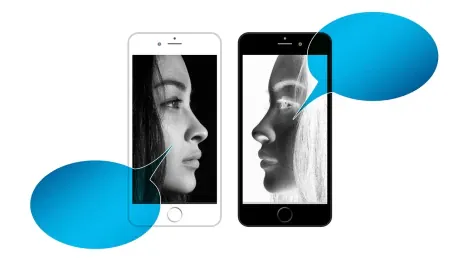Listen to the Article
While visuals capture attention, it’s the brand voice that keeps users connected and helps foster trust. Think of it as the distinct way your company communicates with your audience, employees, and the market, defining how you are perceived across multiple channels, especially as the average person uses 6.83 different social networks per month.
Since today’s business landscape overwhelms consumers with information, building a recognizable and consistent voice is essential. If you haven’t already, it’s time to “speak up” and differentiate through brand voice in a landscape where 82% of consumers buy from brands with which they have a high emotional connection.
Creating a brand voice takes research and teamwork. Many companies undergo branding (or rebranding) by doing deep internal reviews. However, the real test of a brand’s voice isn’t just what the company thinks—it’s how customers react. Businesses that compare how employees view their brand with customer opinions often find big discrepancies.
Read this article to tackle these challenges and explore:
The three elements of brand voice;
How you can shape them to address your ideal customer profile;
And why consistency across channels is essential.
What’s Your Mission?
Before you start, you need to know your brand’s goal inside and out. Your mission statement will guide everything you do—from product development to client interactions. That’s why you should create a mission statement that is clear, short and speaks to the core of your brand’s purpose.
An effective exercise to help you get going is asking the following questions:
What impact do we want to have in the world?
How do we want our customers to feel after they interact with our brand?
What makes our brand irreplaceable to customers?
How will our brand disrupt or improve our industry?
What milestones will mark progress in the next 1 to 5 years?
The Three Elements of Brand Voice
Your brand’s communication strategy rests on three key parts: Tone, language, and personality.
Your tone sets the mood for every interaction and works as your brand’s vocal fingerprint that shapes first impressions and builds trust. Think of how Goldman Sachs uses a formal, authoritative tone to show expertise, while Dove uses warmth to match its empathetic style.
Your language makes your message clear and relatable, ranging from technical precision to user-friendly messaging. You should adjust this balance based on your audience. For instance, Apple uses minimalist language and inspiring storytelling to simplify tech complexity. If this sounds like you, then you can draw inspiration from their approach to product descriptions and landing page copy.
Finally, your personality shows how your brand is seen over time. For example, INFUSE earns trust through its client-centricity, while Tesla stands out for its bold, disruptive innovation.
When you bring these elements together, you create a voice that truly connects with your audience.
Speak to Your Ideal Customer Profile
Building a brand’s tone hinges on understanding the emotional resonance your audience seeks. You need to shape your brand’s tone, language, and personality so it truly resonates with your ideal customer profile by first getting to know your audience’s values, pain points, and communication preferences.
Kick-off by researching your ideal customer profile’s demographics (age, location, and income), psychographics (values, aspirations, lifestyle), and whether they prefer data-driven insights or emotional storytelling. Then you can align your understanding with your brand’s core purpose.
You need to validate and refine your tone by gathering feedback through methods like sentiment analysis of customer interactions or A/B testing of messaging to see what resonates. Anchor your tone in audience psychology and brand intent, and maintain it consistently to create a distinct emotional signature that builds trust and loyalty.
Tap Into the Power of (Correct) Words
Selecting the right brand language means focusing on clarity, relevance, and how well it fits with your audience’s mindset and the role your brand plays in their lives. Start by mapping out your audience’s literacy level, cultural context, and expertise—are they experts who expect precise, industry-specific terms, or generalists who need simple, jargon-free explanations?
For instance, a technical audience might want detailed, acronym-heavy language to signal authority, while a consumer-facing brand should focus on simplicity and relatable metaphors to bridge knowledge gaps. By grounding your language in what your audience needs, the brand’s purpose, and clear meaning, you build a foundation of understanding that drives trust and action.
Fuse Tone and Language for the Right Personality
If your brand were a person, what traits would they have? Would they be honest and reliable, or brave and daring? You need to pick traits that match your company’s core values—like trust or creativity—but also fit what your audience wants. For example, if your brand is all about being open, honesty might be a must. If your audience loves adventure, boldness could help you stand out.
Make sure to remain consistent whether in customer service, ads, or product design as every interaction should feel like it’s coming from the same brand personality. In addition, much like a real person, your brand can grow and evolve, staying fresh without losing what makes it unique.
Consistent Doesn’t Mean Constant
Your brand voice isn’t a one-and-done deal; it evolves with your audience and the market, so you must keep testing, tweaking, and refining based on real feedback. By aligning your messaging across every touchpoint and staying flexible, you not only stand out in a crowded market but also build stronger customer connections and drive long-term brand equity.
It’s important to know when to be brief and when to go deep. Sometimes, you need sharp, punchy messaging to grab attention fast. Other times, a longer, more detailed approach is necessary to fully communicate your message. Adjust your delivery based on what your audience needs.
When you dive into email marketing, make sure your newsletters feel relaxed and engaging, setting them apart from more structured sales messages. You have to keep your brand voice strong and adaptable across all channels because every platform has its own vibe—your website and blog act like trusted experts providing deep insights and long-form content, while social media is your chance to get personal, riding trends and sparking direct conversations.
Conclusion
How your brand looks and sounds shapes how customers feel about you. Without clear rules, things get messy, and trust fades. Fix it by setting simple guidelines for how your brand “talks” and “acts” in writing, keeping everything consistent. Use tools that help your team stay on-brand while they work, preventing accidental tone shifts in emails, ads, or social posts. Consistency builds trust, and trust leads to loyalty—so when customers know what to expect, they’ll keep choosing you.









